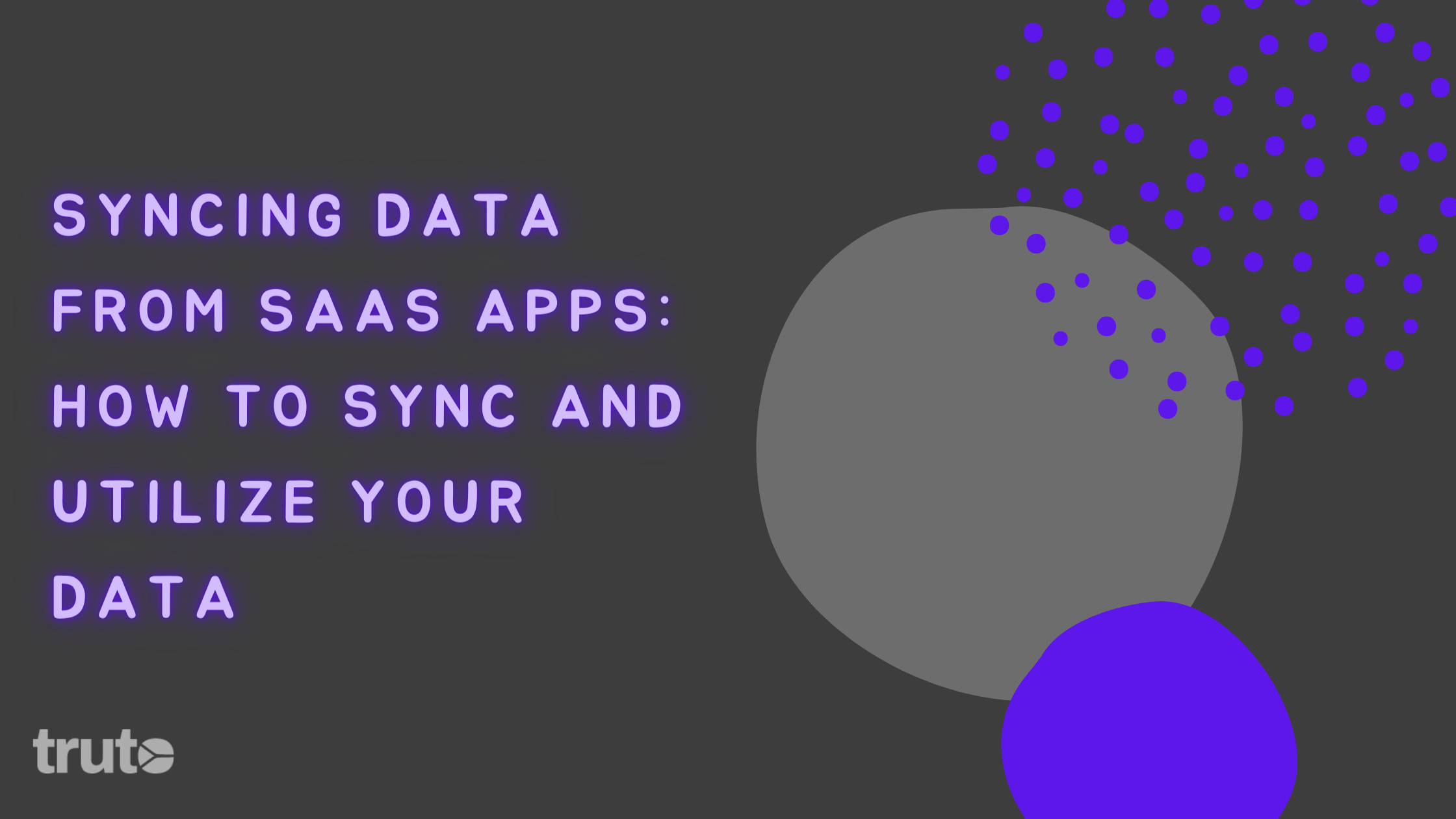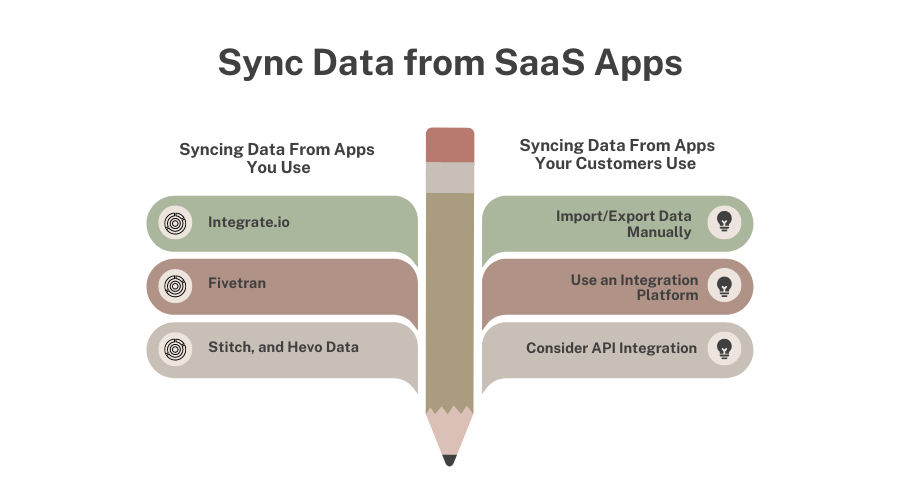Syncing Data from SaaS Apps: All You Need To Know About How to Sync and Utilize Your Data

How to Sync Your Data From SaaS Apps
Before delving deeper into the process of syncing data from SaaS apps, it's important to take a step back and examine the use cases. This post will focus on two specific use cases that are pertinent to the topic at hand:
- Syncing data from apps you use — this could include customer data, transaction data, email lists, project status, etc.
- Syncing data from apps your customers use — examples include CRM tools, project management tools, email marketing tools, accounting software, etc. You are usually presenting this data within your app and building workflows on top.
Here are the options at your disposal based on your use case:
Syncing Data From Apps You Use
While you can build your own infrastructure from scratch to get all the data from various apps in one place, we suggest using a tool to get the job done. Some tools to consider:
Integrate.io
The Integrate.io platform gives you easy access to powerful ETL & Reverse ETL, ELT & CDC, API Management, Free Data Observability, & Data Warehouse Insights all in one Platform... all at an affordable price.
Integrate.io empowers citizen integrators on any team to effectively turn your data warehouse into a data platform that powers decision-making and operational systems.
Fivetran
Shaped by the real-world needs of data analysts, Fivetran technology is the smartest, fastest way to replicate your applications, databases, events and files into a high-performance cloud warehouse. Fivetran connectors deploy in minutes, require zero maintenance, and automatically adjust to source changes — so your data team can stop worrying about engineering and focus on driving insights.
Stitch
Stitch Data Loader is a simple, powerful ETL service for businesses of all sizes, up to and including the enterprise. More than 3,000 companies use Stitch to move billions of records every day from SaaS applications and databases into data warehouses and data lakes, where they can be analyzed with BI tools.
Hevo Data
Hevo Data is a no-code, bi-directional data pipeline platform specially built for modern ETL, ELT, and Reverse ETL Needs. It helps data teams streamline and automate org-wide data flows that result in a saving of ~10 hours of engineering time/week and 10x faster reporting, analytics, and decision-making.
The platform supports 150+ ready-to-use integrations across SaaS Applications, Cloud Databases, Cloud Storage, SDKs, and Streaming Services. Over 1000 data-driven companies spread across 45+ countries trust Hevo for their data integration needs. Try Hevo today and get your fully managed data pipelines up and running in just a few minutes.

Syncing Data From Apps Your Customers Use
Import/Export Data Manually
Importing and exporting data manually can sometimes be the better option if you don't want to spend time building an API for your product. We have seen these decisions being made by teams that are small and are focusing on a fewer set of customers. While this works when you are starting out, you can consider natively integrating your app with other products when you feel you're at a stage where building an API has crossover benefits for your business.
Use an Integration Platform
One of the easiest ways to sync data between SaaS applications is to use an integration platform. An integration platform can connect to multiple applications and automate the syncing process. This can save time and reduce the risk of errors.
There are many integration platforms available, such as Zapier, Integromat, and Make. These platforms typically require you to set up triggers and actions that dictate when and how data should be synced.
Consider API Integration
If an integration platform does not meet your needs, you can also consider API integration. This involves using the application programming interface (API) of each application to sync data. API integration requires some programming knowledge, but it can provide greater flexibility and control over the syncing process.
Most SaaS applications offer APIs that allow you to access and manipulate data programmatically. You will need to familiarize yourself with the APIs of the applications you are using and write code to automate the syncing process, or simply use a unified API platform like Truto that obviates the need to go through each API individually and help you integrate hundreds of apps with one API.
You might also want to choose bi-directional syncing options to ensure there's a seamless experience. With uni-directional sync, you can get your customer's data into your system but sending data back to their system will not be possible. With bi-directional sync, however, you can provide a seamless experience by pulling and pushing data to their system.
It has become increasingly common for businesses to use multiple software-as-a-service (SaaS) apps. These apps provide a range of benefits, from increased efficiency to better data management, but they also come with their own set of challenges. One of the biggest hurdles for businesses is figuring out how to sync data from these various apps to make better decisions.
Fortunately, there are tools available that can help companies quickly and easily sync their data from various SaaS apps. For example, Truto is a powerful tool that can help you synchronize data from all of your cloud-based apps in one central location. With Truto, you can quickly and easily sync data from apps like Salesforce, HubSpot, and Mailchimp, giving you a comprehensive view of your business data in one place.
How to Utilize Your Data
Once you have all of your data synced in one central location, you can start to utilize it to make better decisions for your business. Here are some ways that you can use your synced data to make better decisions:
Identify trends and patterns
One of the most significant benefits of syncing data from various SaaS apps is the ability to identify trends and patterns in your business data. With all of your data in one place, you can quickly analyze it and spot trends that might not be apparent if you were looking at each app individually.
For instance, you might notice a trend of customers who purchase product A are also likely to purchase product B. Armed with this knowledge, you can tailor your marketing efforts to better target these customers.
Track key performance indicators (KPIs)
Another benefit of syncing your data is the ability to track key performance indicators (KPIs) for your business. With all of your data in one central location, you can easily track metrics like sales, customer retention, and website traffic. This can help you make more informed decisions about where to allocate your resources and which areas of your business need improvement.
Streamline workflows
Syncing your data can also help streamline workflows and eliminate redundant tasks. For example, if you have customer data stored in both Salesforce and HubSpot, you can use Truto to sync that data so that you only have to enter it once. This can save your team valuable time and reduce the risk of errors or data duplication.
Personalize customer experiences
By syncing data from various apps, you can create a more personalized experience for your customers. For example, if you have customer data from both Salesforce and Mailchimp, you can use that data to create targeted email campaigns that speak directly to your customers' interests and needs.
Improve collaboration
Syncing your data can also improve collaboration between teams. With all of your data in one central location, teams can easily access the information they need to do their jobs more effectively. This can lead to improved communication and collaboration between teams, which can ultimately lead to better business outcomes.
Syncing data from various SaaS apps can be a challenge for businesses, but it's also essential if you want to make better decisions based on your data. Fortunately, tools like Truto can help you quickly and easily sync your data, giving you a comprehensive view of your business data in one place.
Once you have your data synced, you can use it to identify trends and patterns, track KPIs, streamline workflows, personalize customer experiences, and improve collaboration between teams.
Truto also offers a range of features that developers and engineers will find valuable, including:
- API integration: Truto offers proxy APIs for any SaaS integration, making it easy to integrate with other tools and platforms.
- Advanced unified model: Truto's advanced unified model helps you perform all CRUD operations across all apps you integrate.
- Sync Data Anytime: Truto offers real-time any-time sync. It's your data — you should be able to push & pull anytime and not have to worry about jobs running every few hours or frequencies.
- Data security: Truto takes data security seriously, offering end-to-end encryption. Your customer's data is also not stored on the Truto platform.
We hope this gave you a good overview of why it's important to sync data from various SaaS apps and some ways of setting it up. Share your thoughts on this article? Please write to us at [email protected]
